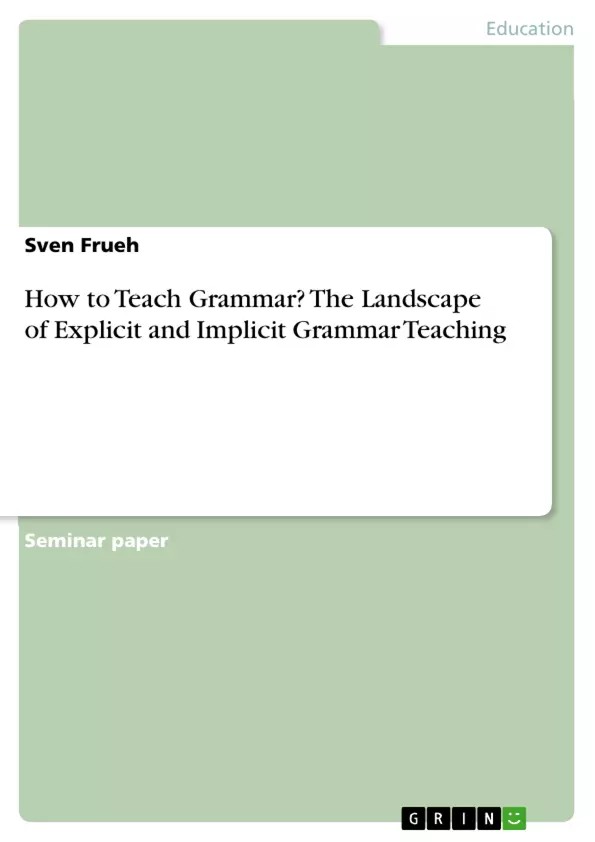This paper aims to answer the questions, to which English grammar varieties students are exposed to, and to which extent they should be addressed in the classroom. Moreover, it aims to shed light on how useful explicit grammar teaching is, compared to implicit methods.
The present paper rests on the hypothesis that non-standard English grammar should be part of grammar teaching in EFL (English as a Foreign Language)classrooms as they are beneficial for students’ language comprehension. Furthermore, explicit grammar instructions may only be useful for mastering specific target structures; however, languages and their underlying grammar systems may only be acquired implicitly, not by learning grammar rules.
Inhaltsverzeichnis (Table of Contents)
- Introduction
- What to teach?
- Official guidelines
- Correct and/or Appropriate
- Lingua Franca
- Spoken Grammar
- Varieties of English
- Explicit and Implicit Grammar Teaching
- Implicit Grammar Teaching
- Explicit Language Teaching
- Comparison of Explicit and Implicit Language teaching
- Conclusion
Zielsetzung und Themenschwerpunkte (Objectives and Key Themes)
The main objective of this paper is to examine the role of nonstandard English grammar in EFL classrooms and argue for its inclusion to enhance students' language comprehension. The paper also explores the effectiveness of explicit grammar instruction versus implicit methods in acquiring grammatical competence.
- The importance of nonstandard English varieties in EFL teaching
- The debate around correct and appropriate grammar in communicative contexts
- The comparison between explicit and implicit grammar instruction methods
- The evolution of grammar teaching methods throughout history
- The focus on communication and real-world language use in contemporary grammar teaching
Zusammenfassung der Kapitel (Chapter Summaries)
- Introduction: This chapter provides a historical overview of grammar teaching, highlighting the evolution of philosophies and methods from ancient times to the present. It discusses the transition from traditional grammar-focused methods to communicative approaches that emphasize language use in real-world settings.
- What to teach?: This chapter explores the issue of grammar content in EFL classrooms. It examines official guidelines like the CEFR and delves into the debate around "correct" versus "appropriate" grammar in communicative contexts. The chapter also discusses the significance of teaching various varieties of English, including spoken grammar and local dialects.
- Explicit and Implicit Grammar Teaching: This chapter introduces the concepts of explicit and implicit grammar instruction. It outlines the characteristics of each approach, emphasizing their respective strengths and limitations in language acquisition.
- Explicit Language Teaching: This chapter provides a detailed analysis of explicit grammar teaching methods. It explores the benefits and drawbacks of using explicit instructions to develop grammatical competence.
- Comparison of Explicit and Implicit Language teaching: This chapter compares and contrasts the effectiveness of explicit and implicit grammar instruction. It considers the impact of each approach on different aspects of language learning, such as fluency, accuracy, and overall communicative competence.
Schlüsselwörter (Keywords)
This paper focuses on key concepts like nonstandard English grammar, explicit and implicit grammar instruction, language acquisition, communicative competence, EFL teaching, and the evolution of grammar teaching methods. It examines various English varieties, including spoken grammar and local dialects, and explores their impact on language comprehension in EFL classrooms.
- Quote paper
- Sven Frueh (Author), 2020, How to Teach Grammar? The Landscape of Explicit and Implicit Grammar Teaching, Munich, GRIN Verlag, https://www.hausarbeiten.de/document/1002056


